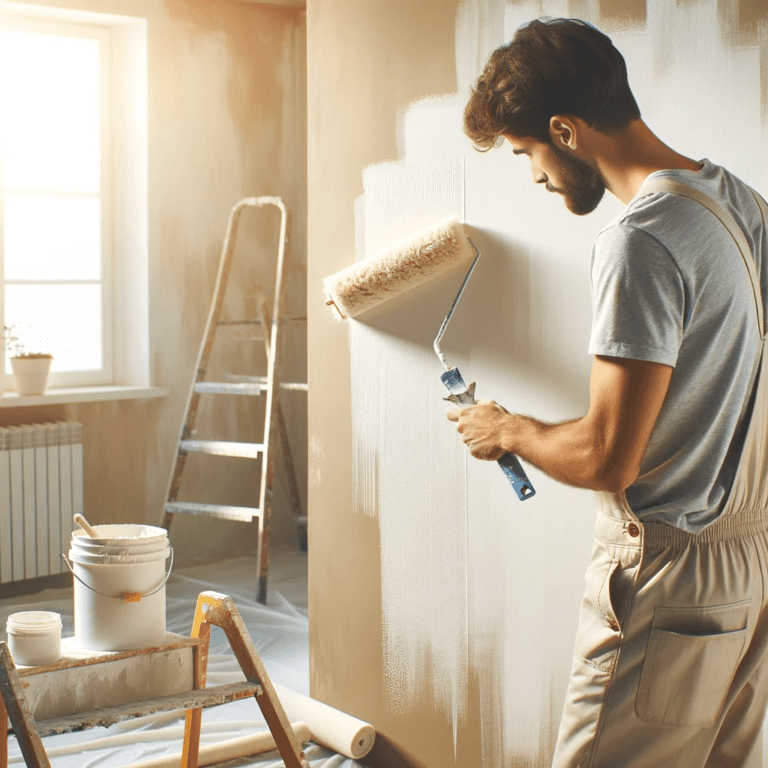Welcome to our guide on selecting the best paint for fresh plaster, a crucial decision for any homeowner or office space owner in London.
Are you struggling with peeling paint, damp walls, or bad finishes? You are not alone. London’s unique architectural landscape presents specific challenges, but fear not, we are here to navigate you through them.
Professional Tested Paint for Fresh Plaster
Not all paints are created equal, especially when it comes to fresh plaster. You need a paint that’s breathable, moisture-resistant, and durable. We recommend high-quality options like acrylic emulsions or silicate paints. These paints not only tackle condensation head-on but also provide a stunning finish that elevates the look of any room.| Paint Brand | Key Features | Durability | Moisture Resistance | Price Range | Ideal Usage |
|---|---|---|---|---|---|
| Dulux Trade Supermatt | Breathable, excellent coverage | High | Moderate | ££ | General, versatile use |
| Johnstone’s Covaplus | High opacity, covers imperfections | Moderate | Moderate | ££ | Covering imperfections |
| Leyland Trade Contract Matt | Cost-effective, good breathability | Moderate | Moderate | £ | Large areas, budget projects |
| Crown Trade Clean Extreme | Scrubbable, durable | High | High | £££ | High-traffic areas |
| Farrow & Ball Modern Emulsion | Luxurious finish, mold resistant | High | High | ££££ | Premium, stylish spaces |
| Armstead Trade Contract Matt | Good coverage, budget-friendly | Moderate | Moderate | £ | General, cost-effective projects |
| Little Greene Intelligent Matt Emulsion | Eco-friendly, elegant finish | High | Moderate | ££££ | Eco-conscious, stylish homes |
What is Fresh Plaster
Fresh plaster is like a blank canvas. It’s porous, absorbing water and moisture, which can be a double edged sword. On the one hand, it allows your paint to bond beautifully, but on the other, it can lead to dampness and peeling if not treated correctly. We’ve seen too many London homes and offices fall victim to these issues, but with the right paint, these can be easily avoided
Creating a mist coat
Creating a mist coat is an essential step when painting fresh plaster. A mist coat is a diluted paint application that allows the plaster to absorb the paint evenly, preventing peeling or patchy coverage. Here’s a step-by-step guide on how to make and apply a mist coat:
Materials Needed:
- Water-based emulsion paint (preferably white or light-colored)
- Clean water
- Mixing bucket
- Stirring stick or tool
- Paintbrush or roller
- Protective sheets or drop cloths
- Masking tape
Steps to Make and Apply a Mist Coat
Prepare the Area:
- Ensure the room is well-ventilated.
- Cover the floor and any furniture with protective sheets or drop cloths.
- Use masking tape to cover edges and protect areas where you don’t want paint.
Check the Plaster:
- Ensure the plaster is completely dry. It usually takes at least 4-6 weeks for new plaster to dry thoroughly.
- The plaster should change from dark to light, indicating it’s dry.
Mixing the Mist Coat:
- In a mixing bucket, combine one part water with three parts emulsion paint.
- Stir well until the mixture is consistent. The consistency should be similar to that of milk.
Applying the Mist Coat:
- Use a brush or roller to apply the mist coat. Start from the top of the wall and work your way down.
- Apply evenly but don’t overload the wall. The mist coat should be thin enough to see the plaster through the paint.
- Avoid painting thick layers as it might peel off once dry.
Drying Time:
- Allow the mist coat to dry completely. This can take a few hours to a day, depending on the room’s temperature and humidity.
Additional Coats:
- After the mist coat has dried, inspect the wall for any imperfections or missed spots.
- If needed, apply a second mist coat following the same process.
- Once the mist coat is fully dry, you can apply your top coats of paint.
Tips:
- Paint Type: Use a water-based emulsion paint for the mist coat. Avoid using vinyl or silk paints as they can create a layer that’s too impermeable and might not adhere well to the plaster.
- Consistency: The key to a good mist coat is its consistency. It should be thin but not too watery.
- Testing: If unsure about the consistency, test on a small, inconspicuous area first.
- Cleaning: After finishing, clean your brushes or rollers immediately with water.
Applying a mist coat is a straightforward but crucial process to ensure a smooth and even finish when painting fresh plaster. It helps the subsequent layers of paint to adhere properly and gives a professional-looking finish.

Expert Application Techniques
Applying paint to fresh plaster is an art. It requires skill and precision, something we at Cloud Painters have perfected over years. We use specific techniques that ensure even coverage and long-lasting results. Our team ensures that every brush stroke adds value to your walls.
Why Choose Cloud Painters ?
Our team doesn’t just apply paint; we bring walls to life. We understand the unique demands of London homes and office spaces. Our clients choose us for our commitment to quality, cost-effective solutions, and unparalleled expertise. Don’t just take our word for it – our portfolio speaks volumes of our excellence.
On a final note
Choosing the right paint for fresh plaster is more than a decorating decision; it’s an investment in your property’s future. With the insights and expertise shared in this post, you’re now equipped to make an informed choice. Remember, great walls are just a brushstroke away. So are You ready to transform your space with the perfect paint? Contact us today and let’s make your vision a reality. Visit our contact page here and take the first step towards a beautiful, lasting finish.



